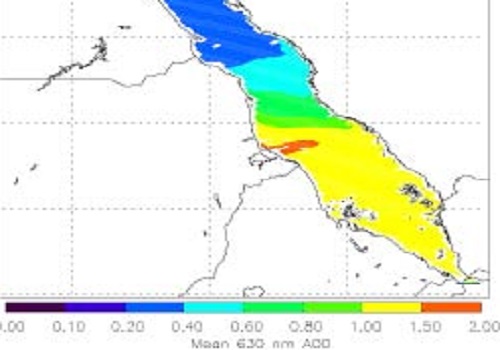Earth Science and Engineering
Effect of dust on the Red Sea
Ship-based studies of dust levels above the Red Sea reveal significant variations and confirm the reliability of satellite monitoring.


Mean aerosol optical depth values (an indirect measure of dust levels) in the air over the Red Sea in summer, showing the distinct north south asymmetry that causes greater atmospheric heating in the south.
© 2015 KAUST
A large and unevenly distributed effect of dust on the energy balance of the Red Sea has been revealed by a team of KAUST and international scientists1.
“Quantifying the impact of aerosol particles such as dust on the Earth’s climate is one of the key challenges facing climate scientists today,” said Professor Georgiy Stenchikov from the KAUST team.
This latest discovery is among a series of results to clarify the significance of airborne dust for climate, weather and many other impacts across the Middle East. This information will impact a wide range of fields, including weather forecasting, pollution controls and maximizing use of the natural resources from land and sea.
Investigations into dust and climate interactions have taken place across the world, but relatively little attention has focused on the Arabian Peninsula and the Red Sea. To fill this gap, Stenchikov and Sergey Osipov from KAUST worked with collaborators from Imperial College London (U.K.) and the Sigma Space Corporation and NASA’s Goddard Space Flight Center, both in the U.S.
Data was collected using ship-based observations gathered on a series of cruises in the Red Sea. A photometer instrument assessed the dust content of the atmosphere by measuring how much solar radiation at selected wavelengths penetrated to the surface. This data can be used to calculate the radiative effect of the dust, which is essentially its heating or cooling effect in the atmosphere and at the surface of the sea.
The net effect of the dust over the Red Sea causes heating of the atmosphere and cooling of the sea surface due to the dust absorbing and scattering solar radiation. The researchers were surprised, however, to find how uneven the effects of the dust are, both with location and season. There was a distinct north to south gradient across the Red Sea, with greater dust and consequent atmospheric heating in the south, and this gradient was significantly enhanced in the summer compared to in the winter.
“We expect this asymmetric effect will significantly influence regional atmospheric and ocean circulation,” Stenchikov said.
Stenchikov also emphasized that the spatially uneven deposition of dust can affect the nutrient levels in the sea, influencing the productivity of the fisheries that are a key part of the region’s economy.
Another useful result from the ship-based surveys was to find good agreement between these direct measurements and values assessed remotely by satellite. This will improve confidence in satellite-based measurements in future.
References
- Brindley, H., Osipov, S., Bantges, R., Smirnov, A., Banks, J. et al. An assessment of the quality of aerosol retrievals over the Red Sea and evaluation of the climatological cloud-free dust direct radiative effect in the region. Journal of Geophysical Research: Atmospheres 120 10,862-10,878 (2015).| article
You might also like

Earth Science and Engineering
Sensing color cues to monitor coral health in the Red Sea

Earth Science and Engineering
Kahramanmaraş earthquake study showcases potential slip rate errors

Chemical Engineering
Unveiling the role of biomass-burning aerosols in atmospheric reactions

Earth Science and Engineering
Feeling the heat across the Middle East

Applied Mathematics and Computational Sciences
Past and future drought patterns across the Arabian Peninsula

Earth Science and Engineering
Fewer major earthquakes for the northern Dead Sea Fault

Applied Mathematics and Computational Sciences
Measuring the impact of desert greening

Applied Mathematics and Computational Sciences



